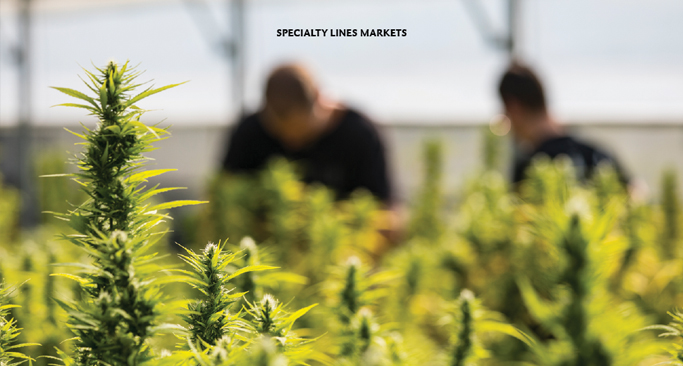Producers and carriers adapt to prolonged legal limbo
By Joseph S. Harrington, CPCU
The march to legalize recreational use of cannabis continues, with 14 states acting to do so over the past four years, mostly by voter referendum. Today, 24 states and the District of Columbia allow some form of cannabis consumption without medical authorization; 38 states and D.C. allow the use of cannabis for medicinal purposes.
As that progression continues, however, another reality is becoming more apparent: a prolonged and perhaps permanent division between states that allow recreational use of cannabis and those that don’t. In itself, that’s not unusual, as there are other commodities, such as fireworks, that are legal in some states but not in others.
With cannabis, however, there is the lingering complication of having the substance listed by the federal government as a Schedule 1 controlled substance prohibited from private possession. For cannabis enterprises and those seeking to insure them, this legal cloud effectively prevents the establishment of an interstate market with clear rules and regulations.
The federal government appears to be in no hurry to clarify the matter. While marijuana legalization draws widespread support in opinion polling, a vote in Congress to legalize would still carry some risk among some constituencies.
Even short of “de-listing” cannabis, Congress has moved at a snail’s pace to create legal “safe harbors” for banks and insurance companies to serve cannabis enterprises without risking legal jeopardy. After several years of consideration, a bill to allow banks to serve cannabis firms has passed the U.S. Senate Banking Committee and awaits action by the full Senate. A bill to allow insurers to underwrite the sector has been introduced in the Senate, but no action has yet been taken.
There is little if any action on the matter in the U.S. House, where partisan gridlock is stalling action on matters far more important than marijuana.
Pushed aside
The topic of cannabis often gets “pushed to the wayside” in Congress, according to Erich Schutz, vice president of Jencap Specialty Insurance Services. “With so much taking place [in the world], we need to have the right setting. I’m not surprised we are where we are.”
So far, “federal inaction [on cannabis] has not impacted our business much at all,” says Nick Smith, assistant vice president of life sciences for James River Insurance Company. “Our book of business has grown as more states have moved toward legalization. However, federal legalization or some other sort of federal approval could also allow nationwide growth for the industry, providing greater opportunity for all market segments,” he adds.
Federal inaction inhibits interstate commerce in cannabis, according to Thomas Cioletti, program manager for McGowan Wholesale. Because of state variations in the substance and timing of cannabis regulations, “some states wind up with too much cannabis being produced for the number of licensed dispensaries while others experience a product shortage.”
As an example, Cioletti cites the contrasting conditions in Pennsylvania and New Jersey. Pennsylvania voters have so far refused to authorize recreational use of cannabis, frustrating cultivators in the state who have invested in production in anticipation of an expanded network of dispensaries. Meanwhile, on the other side of the Delaware River, cannabis distributors face a shortage of product as legal action has resulted in delays in the licensing of cultivation operations.
“If commerce between these two neighboring states was allowed, they could have solved each other’s problem,” Cioletti says. “The excess product from Pennsylvania could have been sold to dispensaries in New Jersey.”
In all, he says, “the relatively immature nature of the industry and the slow movement by the federal government to provide solutions are causing the understandably risk- averse insurance industry to wade into the waters slowly.”

–
–
“Capacity in this maturing market is such that buyers are usually able to buy the limits they seek”.
—Charles Pyfrom
Chief Marketing Officer
CannGen Insurance Services
–
Ambiguities and uncertainties in federal policy regarding cannabis have a direct impact on insurers seeking to serve the market for it, according to Jason Scheurle, national product leader for cannabis at Burns & Wilcox.
As the cannabis market “operates on a state-by-state basis,” he says, “there are wildly different approaches from state to state in terms of policy form language and rates for coverage.” He adds that insurers shy away from writing transit coverage on cannabis shipments for fear of violating state laws or federal interstate commerce regulations.
All this helps explain why nearly 90% of cannabis coverage is written in the E&S market, according to Scheurle.
It also explains why some reinsurers are reluctant to underwrite cannabis carriers, according to Charles Pyfrom, chief marketing officer of CannGen Insurance Services. While there has been growth in this class of business, Pyfrom says that “federal action [to clarity legal matters] would create new opportunities” and “end-buyers of coverage would benefit if more reinsurers felt comfortable participating.”
Theft and fire
For a new and rapidly growing class of business, cannabis is showing remarkable stability in its loss experience: Fire is the leading cause of loss for cultivators; theft is the leading cause of loss for distributors.
The theft problem reflects the fact that small quantities of cannabis, easily concealed and carried off, can be sold for substantial amounts in areas where cannabis is still illegal. Federal policy compounds the problem, says Cioletti. “With limited availability of banking and electronic payment services, cash remains the main form of payment accepted by cannabis dispensaries,” he says. “Combine that with a robust black market still operating in many states, and you have an industry highly attractive to criminals.”
According to Schutz, employee dishonesty is directly or indirectly involved in up to 70% of cannabis theft claims. Therefore, in addition to security infrastructure—including cameras, a vault room, and motion sensors—he advises cannabis distributors to “take care of your people. Protect your people and pay them well,” he says. “Don’t give them reason to cheat you.”

–“The relatively immature nature of the industry and the slow movement by the federal government to provide solutions are causing the understandably risk-averse insurance industry to wade into the waters slowly.”
—Thomas Cioletti
Program Manager
McGowan Wholesale
–
Fire loss, the leading driver of property claim severity for cannabis operations, is a function of faulty, outdated, or mishandled growing lights, a standard fixture of most cannabis production operations. Here, Scheurle says his company relies on rigorous fire inspections and often requires installation of sprinklers and fire-proof storage safes, in addition to shatter-proof glass showcases (the last to curb theft losses).
–
–
“[T]here are wildly different approaches from state to state in terms of policy form language and rates … .”
—Jason Scheurle
National Product Leader for Cannabis
Burns & Wilcox
–
Infusion exposure
As a substance that affects users’ mental functions, cannabis invites comparison to alcohol in its potential for impaired users to cause bodily injury or property damage while under its influence.

So far, cannabis appears to be no more dangerous than alcohol in this regard, and perhaps less so. But public offerings of cannabis outside the home is only in its infancy. According to Pyfrom, only a few insurers are cautiously venturing into providing intoxication coverage for newly emerging “consumption lounges,” where patrons are served cannabis as a bar serves alcohol.
There’s another development in the cannabis business that is changing the liability profile of drinking establishments: alcoholic beverages infused with cannabis-based derivatives. “Are the effects of these drinks covered under liquor liability policies?” asks Scheurle. “What if a policy is silent on the matter? For me, I would want to know upfront if there was coverage or not.”
Pyfrom and Scheurle both cite another common liability exposure for cannabis that has nothing to do with its consumption. In the new, expanding, but state-bounded market for cannabis, there are numerous claims within and among cannabis enterprises for brand infringement, joint venture disputes, and misrepresentations of levels of THC and CBD, the mind-affecting substances in cannabis.

–
–
“[F]ederal legalization or some other sort of federal approval could … allow nationwide growth for the industry … .”
—Nick Smith
Assistant Vice President, Life Sciences
James River Insurance Company
–
Sufficient capacity
When it comes to insurance underwriting capacity for the cannabis market, one could say that the slow walking of federal policy works two ways. Lack of complete legal clarity almost certainly prevents some would-be cannabis insurers (especially among admitted carriers) from taking the plunge. But the legal limbo also retards the growth of the business, reducing the demand for coverage.
In light of that, Smith finds “the current market for cannabis enterprises remains competitive, with a healthy amount of capacity available.
“Rates had somewhat found an equilibrium in recent years, but a steady stream of new participants has applied some downward pressure of late,” he adds. “In response, some carriers are offering more supplemental coverages, such as product withdrawal expense reimbursement, to their standard offerings.”
“The market is in flux,” says Cioletti. “Property capacity continues to be tight, but rates have softened compared to other retail exposures.
“We are also seeing a softening of product liability rates from a year or two ago, when uncertainty over the potential rate of claims led carriers to insist on high premiums in anticipation of large losses, which haven’t yet materialized.”
“Capacity in this maturing market is such that buyers are usually able to buy the limits they seek,” says Pyfrom. “Individuals manage to find the coverage limits they want.”
Given the prospects for prolonged fragmentation of the market for recreational cannabis, success in insuring it will fall to producers and underwriters who master the nuances of each state.
“Understanding state and local cannabis law is the key to profitable underwriting,” says Smith. “Regulations can vary widely by jurisdiction, so it is important to evaluate and price based on the location of a risk, in addition to the applicant’s risk profile and loss control.”
For more information:
Burns & Wilcox
burnsandwilcox.com/cannabis
CannGen Insurance Services
canngenins.com
James River Insurance Company
jrvrgroup.com
Jencap Specialty Insurance Services
jencapgroup.com/cannabis
McGowan Wholesale
mcgowanwholesale.com
The author
Joseph S. Harrington, CPCU, is an independent business writer specializing in property and casualty insurance coverages and operations. For 21 years, Joe was the communications director for the American Association of Insurance Services (AAIS), a P-C advisory organization. Prior to that, Joe worked in journalism and as a reporter and editor in financial services.






